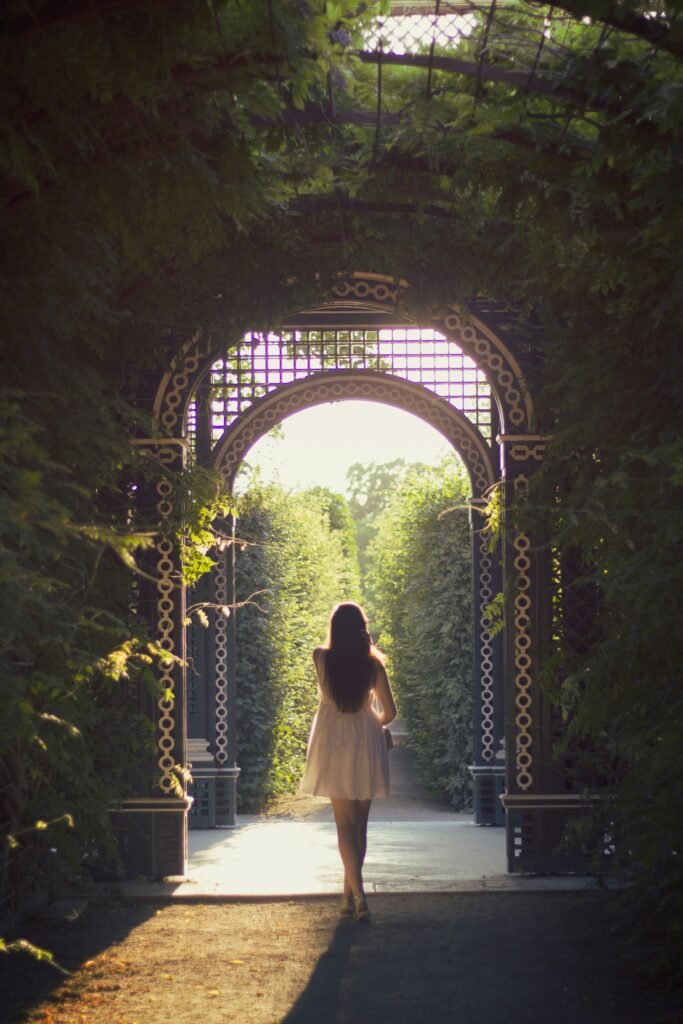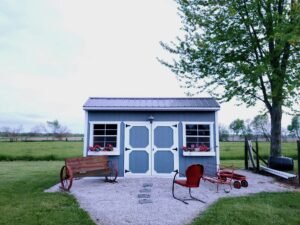The Aesthetics of Sheds and Making Them Garden Features
 Introduction
Introduction
The humble shed is often helpful in landscaping and garden design, storing tools, equipment, and various odds and ends. However, with a touch of creativity and thoughtful design consideration, sheds have the potential to become captivating focal points within a garden setting.
This article explores the artistry of constructing sheds, studying methods to transform them from basic storage structures into delightful garden features. These techniques enhance their aesthetic appeal and ensure they fulfill practical functions in outdoor environments.
Exploring Shed Aesthetics
 Sheds come in many shapes, sizes, and styles, offering ample opportunities for customization and personalization. From traditional wooden structures to sleek modern designs, the aesthetics of sheds can vary widely depending on materials, architectural features, and decorative elements. When envisioning your shed as a garden feature, consider how its design can harmonize with the landscape and complement existing elements such as plants, pathways, and outdoor furniture.
Sheds come in many shapes, sizes, and styles, offering ample opportunities for customization and personalization. From traditional wooden structures to sleek modern designs, the aesthetics of sheds can vary widely depending on materials, architectural features, and decorative elements. When envisioning your shed as a garden feature, consider how its design can harmonize with the landscape and complement existing elements such as plants, pathways, and outdoor furniture.
Choosing the Right Shed Design
The first step in making your shed a garden feature is selecting a design that aligns with your aesthetic preferences and complements the character of your outdoor space. Traditional designs with pitched roofs and rustic charm may evoke a quaint cottage feel. In contrast, contemporary designs with clean lines and minimalist aesthetics can lend a modern touch to your garden. Take cues from the architectural style of your home and the surrounding landscape to ensure coherence and visual continuity.
Incorporating Natural Materials
Consider incorporating natural materials such as wood, stones, and clay during your shed’s construction and interior decoration to elevate its visual charm with a hint of nature. Wood, in particular, offers warmth and texture, evoking a connection to the natural world. Opt for sustainably sourced timber or reclaimed wood for an eco-friendly touch. Stone accents can add visual interest and rugged elegance, while clay or terracotta tiles enhance the roof or facade with earthy tones and tactile appeal.
Embracing Decorative Details
Small details can make a big difference in enhancing your shed’s aesthetic appeal. Consider adding decorative elements like window boxes filled with vibrant flowers, decorative trim, or intricately carved accents. These embellishments can add charm and character to your shed while reinforcing its role as a focal point in the garden. Experiment with colour schemes that complement the surrounding landscape, opting for hues that harmonize with the natural palette of your plants and flowers.
Creating a Seamless Integration
Focus on seamlessly integrating the structure and surroundings to elevate your shed into a garden feature. Please pay attention to placement, ensuring the shed is positioned strategically to maximize its visual impact while maintaining functionality. Consider surrounding the shed with lush greenery or incorporating it into a garden bed to soften its edges and integrate it into the landscape. Pathways leading to the shed can further enhance its accessibility and invitation.
Enhancing Functionality
While aesthetics are paramount, practical considerations should be considered when designing your shed as a garden feature. Ensure the interior layout is optimized for storage and organization, with shelves, hooks, and compartments to accommodate gardening tools, pots, and supplies. Integrate elements like windows and skylights to enhance the flow of natural light and airflow, crafting a delightful space ideal for tending to plants or unwinding amidst your serene garden retreat.
Practical Considerations for Aesthetic Sheds
 Creating an aesthetic shed involves more than just focusing on visual appeal. It’s essential to consider practical aspects to ensure the shed looks good and serves its purpose effectively. Here are some practical considerations to keep in mind:
Creating an aesthetic shed involves more than just focusing on visual appeal. It’s essential to consider practical aspects to ensure the shed looks good and serves its purpose effectively. Here are some practical considerations to keep in mind:
- Functionality: Before delving into the visual appeal, consider the primary purpose of the shed. Will it serve primarily as storage, a workspace, or a combination?
- Understanding its purpose will guide design decisions and layout choices.
- Size and Scale: Decide on the ideal dimensions for the shed according to your requirements and the space you have at your disposal. Consider the storage space required for tools, equipment, and supplies and any additional functions, such as a potting area or workshop.
- Location: Carefully select the shed’s location within your garden or outdoor space. Ensure it is easily accessible, preferably close to where you’ll be working, but also consider factors such as sunlight exposure, drainage, and views from other garden areas.
- Foundation and Stability: A sturdy foundation is essential to ensure the shed remains stable and level over time. Depending on the shed’s size and weight, you may need a concrete slab, gravel base, or treated lumber foundation to support it adequately.
- Weather Resistance: Choose durable materials and construction methods to withstand the elements. The shed should be weatherproofed to protect its contents from rain, snow, and humidity. Consider adding proper insulation and ventilation to regulate temperature and prevent moisture buildup.
- Security: Install secure locks and hardware to protect valuable items in the shed. Consider adding motion-sensor lights or an alarm system for security, mainly if the shed contains expensive tools or equipment.
- Maintenance: When designing your shed, factor in the ongoing maintenance requirements. Choose materials and surface finishes that simplify cleaning and maintenance, and establish a schedule for regular inspections to promptly identify and address any possible problems.
- Accessibility: Ensure the shed is accessible to all users, including those with mobility challenges. Install ramps, wide doorways, and ergonomic storage solutions to facilitate easy entry and movement inside the shed.
- Utilities and Services: If you plan to use the shed as a workshop or garden retreat, consider installing electricity, water, and plumbing. This will enhance its functionality and versatility but may require professional installation and permits.
- Integration with Landscape: Finally, integrate the shed into the surrounding landscape to enhance its aesthetic appeal. Soften harsh lines with landscaping features such as flower beds, shrubs, and climbing vines. Choose paint colours and finishes that complement the natural elements of your garden.
By addressing these practical and aesthetic considerations, you can create a beautiful shed that meets your functional needs and enhances your outdoor living experience.
Tips and Techniques
 When transforming a shed into a garden feature, it’s essential to consider both aesthetic appeal and practical functionality. Here are some tips and techniques to help you achieve the perfect balance:
When transforming a shed into a garden feature, it’s essential to consider both aesthetic appeal and practical functionality. Here are some tips and techniques to help you achieve the perfect balance:
- Optimize Storage Space: While focusing on aesthetics, ensure your shed remains functional for storage purposes. Set up shelves, racks, and storage bins to maintain order and convenient access to gardening tools, gear, and supplies.
- Maximize Natural Light: Incorporate windows, skylights, or even glass doors to allow ample natural light into the shed. This enhances the aesthetic appeal and creates a bright and inviting space for gardening activities.
- Consider Ventilation: Adequate ventilation is essential for preventing moisture accumulation and ensuring a healthy indoor environment within the shed. Install vents or louvres to promote airflow and prevent issues such as mould and mildew.
- Weatherproofing: To protect your shed and its contents from the elements, ensure it is properly weatherproofed. This might include filling openings, adding a weatherproof coating to outer areas, and opting for sturdy materials capable of enduring sun, rain, and wind exposure.
- Accessibility: Design the shed layout with accessibility in mind. Logically arrange storage areas and workspaces to facilitate ease of use. Consider adding ramps or wide doorways to accommodate wheelbarrows or larger gardening equipment.
- Maintenance: Regular maintenance is essential to preserve your shed’s aesthetic appeal and functionality. Arrange regular assessments to detect any indications of harm or deterioration and carry out basic maintenance or enhancements accordingly.
DIY vs. Professional Installation
Determining whether to undertake the project personally or enlist the help of a professional relies on several factors, such as your skill level, the time you have available, and your budget:
- DIY: DIY may be a viable option if you have experience with woodworking or construction projects and enjoy hands-on work. It allows for greater customization and control over the design process, and you can save on labour costs. However, be prepared to invest time and effort in planning, sourcing materials, and executing the project.
- Professional Installation: Hiring a professional can ensure high-quality craftsmanship and expedite construction. Professionals have the skills and equipment to tackle complex builds and may offer valuable insights and recommendations. While it typically involves higher upfront costs, professional installation can save you time and provide peace of mind, knowing the job is being handled by experts.
Designs for Aesthetic Sheds
When creating an aesthetic shed, the design is crucial in defining its visual appeal and overall ambiance. Here are several design ideas that can elevate your shed into a stunning garden feature:
- Traditional Cottage Style:
- Pitched roofs, charming dormer windows, and rustic details characterize it.
- Incorporates traditional materials such as wood siding, cedar shingles, and quaint shutters.
- It evokes a cozy, cottage-like atmosphere that blends seamlessly with garden surroundings.
- It is ideal for gardens with a classic, romantic aesthetic.
- Modern Minimalism:
- Features sleek lines, clean geometric shapes, and minimalist detailing.
- Utilizes contemporary materials such as metal panels, concrete, and glass.
- Emphasizes simplicity, functionality, and a sense of spaciousness.
- Contrasts with natural elements in the garden for a striking, avant-garde look.
- Rustic Barn Style:
- Traditional barn structures inspired me with gambrel roofs and large sliding doors.
- Incorporates reclaimed wood, corrugated metal, and vintage hardware for an authentic rustic feel.
- It offers ample storage space and can double as a workshop or studio.
- Brings a hint of countryside appeal and fond memories to the outdoor scenery.
- Victorian Elegance:
- Ornate details, decorative trim, and intricate embellishments characterize it.
- Features gabled roofs, decorative finials, and stained glass windows.
- Incorporates Victorian-era architectural elements such as gingerbread trim and latticework.
- Adds a sense of timeless elegance and sophistication to the garden setting.
- Asian Zen Retreat:
- Draw inspiration from Japanese tea houses and Zen gardens.
- Features clean lines, natural materials, and a serene, minimalist design.
- It utilizes wood, bamboo, and stone to harmonize with nature.
- Creates a tranquil sanctuary for meditation, reflection, or contemplation amidst the garden’s beauty.
- Eclectic Bohemian Vibe:
- Embraces an eclectic mix of colours, textures, and patterns.
- Incorporates salvaged materials, vintage furnishings, and whimsical decorations.
- Encourages creativity and personal expression with a laid-back, bohemian aesthetic.
- Allows a playful, non-conformist approach to shed design that reflects your unique style and personality.
- Contemporary Garden Pavilion:
- Combines elements of traditional garden pavilions with modern design principles.
- Features open, airy spaces, floor-to-ceiling windows, and seamless indoor-outdoor transitions.
- Combines elements like wood and stone with modern, minimalist design touches.
- It provides a versatile space for entertaining, relaxing, or enjoying panoramic views of the garden.
- Green Roof Eco-Shed:
-
- Integrates living vegetation on the roof surface for added insulation, biodiversity, and aesthetic appeal.
- Features a sloped or flat roof structure designed to support a variety of plants, including sedums, grasses, and wildflowers.
- It enhances energy efficiency, reduces stormwater runoff, and provides a habitat for birds and insects.
- It blends harmoniously with the surrounding landscape while promoting sustainability and environmental stewardship.
Choose a design that mirrors your individual preferences, complements the architectural elements of your home, and effortlessly integrates with the natural environment of your garden. Whether you prefer a traditional cottage retreat, a modern minimalist studio, or an eclectic bohemian hideaway, the key is to create a shed that enhances the beauty of your outdoor space and reflects your individuality and quality of life.
FAQs (Frequently Asked Questions)
- What permits are required to build a shed?: Regulations vary depending on location, but typically, you’ll need a license for sheds above a specific size. Check with your local building department for specific requirements.
- What are the best materials for shed construction?: Common options include wood, metal, and vinyl. Each has its advantages and considerations regarding durability, maintenance, and aesthetics.
- Can I transform a pre-existing shed into a garden focal point? Existing sheds can be renovated and upgraded to enhance their aesthetic appeal. Consider adding decorative elements, repainting, or installing new doors and windows to give the shed a fresh look.
- How can I personalize my shed’s design?: Incorporate personal touches such as custom paint colours, decorative trim, or unique hardware to reflect your style and preferences.
- Are there any eco-friendly options for shed construction?: Yes, eco-friendly materials such as reclaimed wood, recycled metal, and sustainable composite materials are available for environmentally conscious builders.
Materials and Cost Analysis:
| Material | Cost (per square foot) | Pros | Cons |
| Wood | $10 – $30 | Natural aesthetic, easy to customize, renewable resource | Necessitates routine upkeep, prone to decay and infestation by pests. |
| Metal | $15 – $35 | Durable, low maintenance, fire-resistant | Limited design options may rust over time |
| Vinyl | $15 – $30 | Low maintenance, moisture-resistant, long-lasting | Limited colour options, less environmentally friendly |
| Composite | $20 – $40 | Durable, eco-friendly, low maintenance | Higher upfront cost, limited availability of styles |
Note: Costs are approximate and may vary depending on quality, size, and location.
By considering these practical aspects, leveraging tips and techniques, and weighing DIY versus professional installation, you can create an aesthetic shed that enhances your garden and serves as a functional and inviting space for your outdoor activities.
Key Takeaways
- Design Variety: Aesthetic sheds are available in a range of designs, spanning from classic cottages to sleek modern styles, offering the flexibility for customization to match individuals’ unique preferences and tastes.
- Materials Matter: Choose materials that enhance the shed’s visual appeal and offer durability, weather resistance, and sustainability. Options include wood, metal, vinyl, and eco-friendly composites.
- Functionality First: While aesthetics are important, prioritize functionality when designing your shed. Consider its intended use, size, location, and practical features such as storage, accessibility, and ventilation.
- Integration with Landscape: Seamlessly integrate the shed into the garden landscape by considering its placement, surroundings, and architectural features. Soften harsh lines with landscaping elements and choose colours and finishes that complement the natural environment.
- DIY vs. Professional Installation: Based on your skills, time availability, and budget, decide whether to tackle the project yourself or hire a professional. DIY offers customization and cost savings but requires time and effort, while professional installation ensures quality craftsmanship and peace of mind.
- Practical Considerations: Address practical considerations such as foundation, weatherproofing, security, and maintenance to ensure the shed remains functional and durable.
- Personalization and Creativity: Infuse your shed with personal touches, decorative details, and creative flourishes to uniquely express your style and personality.
- Environmental Considerations: To minimize environmental impact and promote sustainability, explore eco-friendly options such as reclaimed materials, green roofs, and sustainable construction practices.
By incorporating these critical takeaways into your shed design process, you can create a beautiful and functional garden feature that enhances your outdoor space and enriches your lifestyle.
Conclusion
In garden design, the shed is uniquely positioned as a practical storage solution and a potential focal point for aesthetic enhancement.
You can convert your shed into a captivating garden focal point by thoughtfully examining the layout, choice of materials, and practical aspects. This enhances the aesthetics of your outdoor area and provides a valuable and adaptable addition to your space.
From traditional cottage-style retreats to modern minimalist pavilions, the options for aesthetic shed designs are endless, offering opportunities for personalization and creativity. Whether you’re drawn to rustic charm, contemporary elegance, or eclectic bohemian vibes, a design aesthetic suits every taste and preference.
However, aesthetics alone are not enough. It’s essential to prioritize functionality, ensuring that the shed meets your practical needs for storage, workspace, and accessibility. Various factors must be considered when designing a shed, such as its dimensions, placement, durability against weather conditions, and security measures.
By taking these aspects into account, you can create a shed that appears appealing and ensures resilience and enduring safeguarding.
Whether you choose to tackle a do-it-yourself project or seek assistance from experts, it’s crucial to approach shed design with careful consideration and a comprehensive outlook.
Integrate the shed seamlessly into the surrounding landscape, harmonizing with the natural elements of your garden while adding depth and character to the outdoor space.
First and foremost, allow your imagination to take flight, and fully embrace the chance to showcase your personality and unique style in your shed design. Whether through decorative details, personalized touches, or eco-friendly features, make your shed a reflection of who you are and how you envision your outdoor living experience.
In the end, a well-designed and aesthetically pleasing shed is more than just a storage space—it’s a sanctuary, a retreat, and a source of inspiration that enhances your connection to nature and enriches your daily life in the garden. So go ahead, unleash your creativity, and embark on the journey of transforming your shed into an actual garden masterpiece.
- Splash of Color: Creative Garden Shed Painting Ideas to Transform Your Backyard Oasis
- The Benefits and Types of Mobile Home Sheds
- History of the World in 100 Sheds
- Garden Shed Roof Repair Guide: Fix Leaks Quickly and Effectively
- Effective Garden Shed Pest Control Methods
- Designing Your Perfect Custom Garden Shed: A Comprehensive Guide
- Best Large Garden Sheds for Your Backyard: Discover the Perfect Storage Solution
- Transform Your Garden Shed: Creative Painting Ideas to Refresh Your Outdoor Space
- Top Small Garden Shed Ideas: Maximizing Your Garden Space
- The Pros and Cons of Metal Garden Sheds: Is It the Right Choice for You?

Leave a Reply